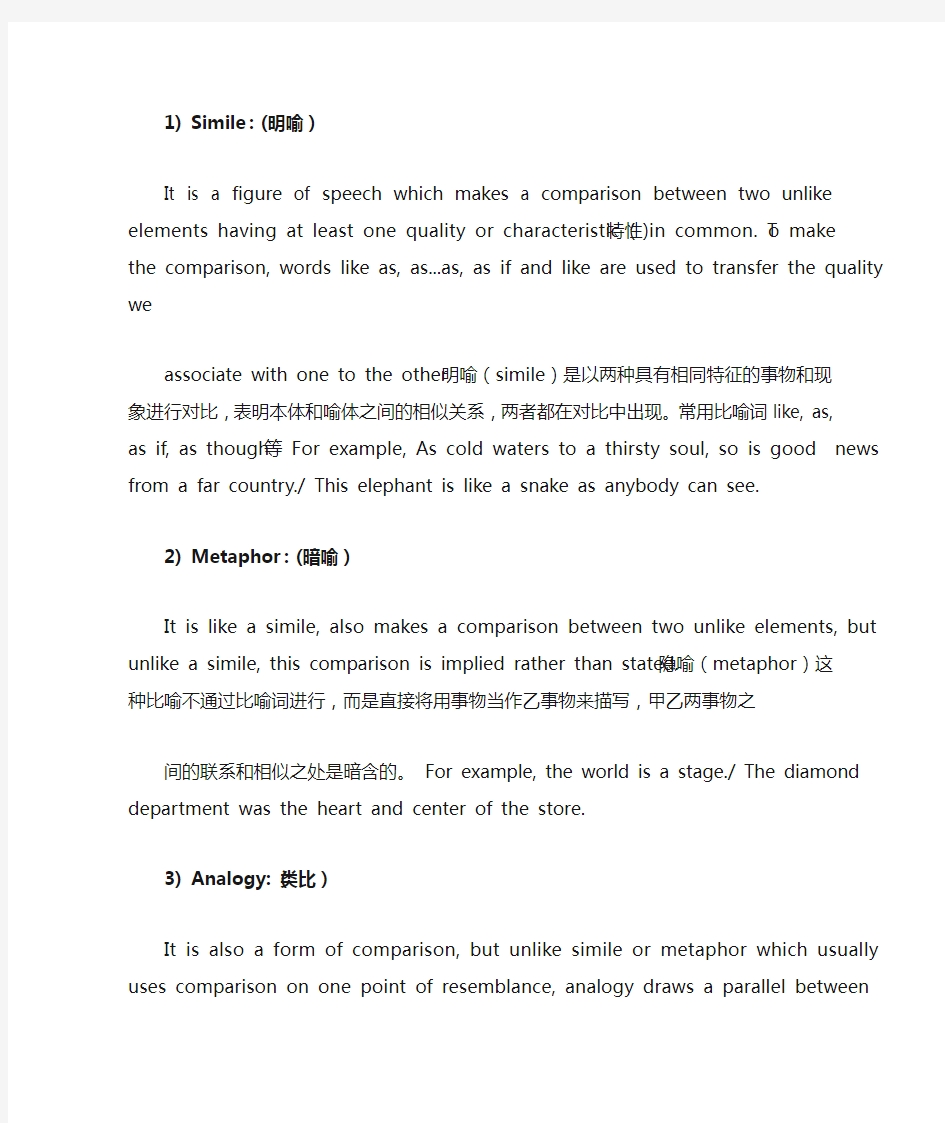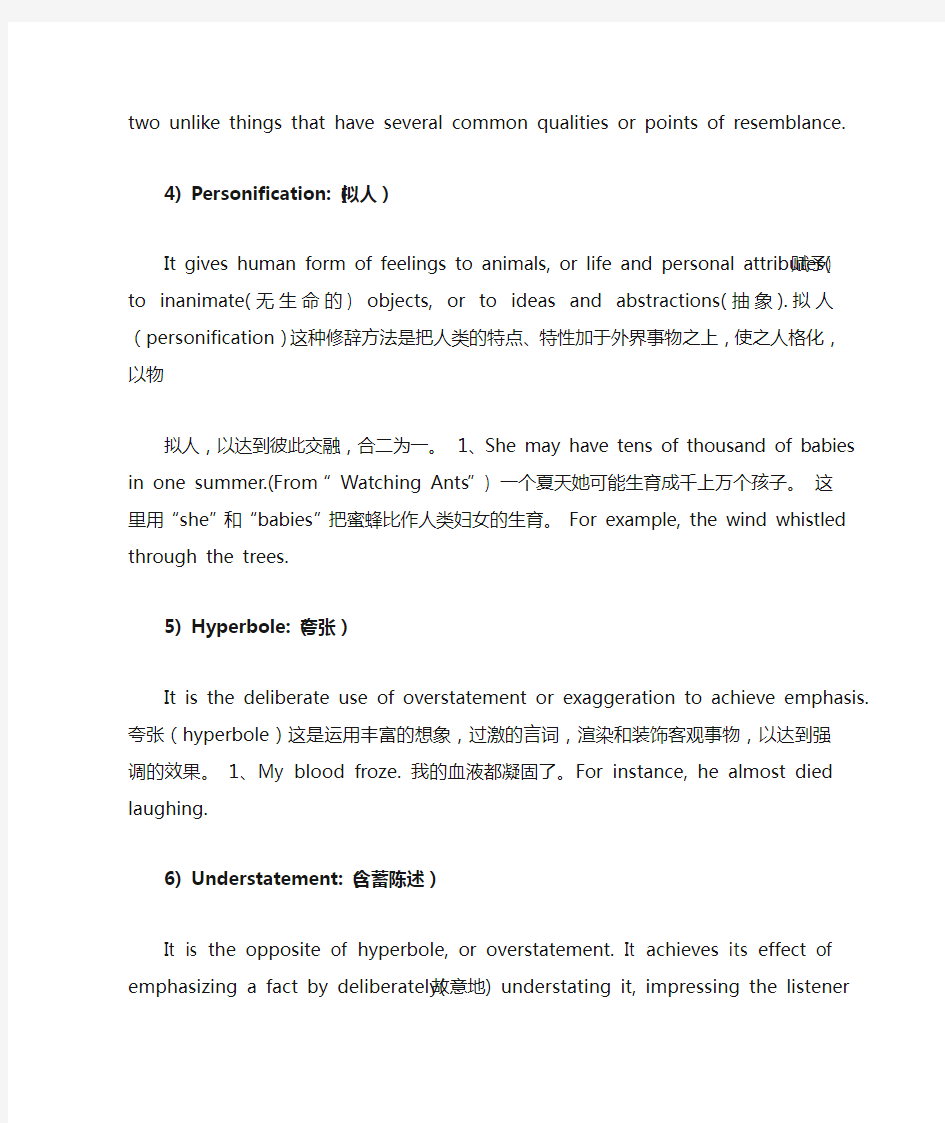the figure of speech


1) Simile:(明喻)
It is a figure of speech which makes a comparison between two unlike elements having at least one quality or characteristic (特性)in common. To make the comparison, words like as, as...as, as if and like are used to transfer the quality we
associate with one to the other 明喻(simile)是以两种具有相同特征的事物和现象进行对比,表明本体和喻体之间的相似关系,两者都在对比中出现。常用比喻词like, as, as if, as though 等For example, As cold waters to a thirsty soul, so is good news from a far country./ This elephant is like a snake as anybody can see.
2) Metaphor:(暗喻)
It is like a simile, also makes a comparison between two unlike elements, but unlike a simile, this comparison is implied rather than stated. 隐喻(metaphor)这种比喻不通过比喻词进行,而是直接将用事物当作乙事物来描写,甲乙两事物之
间的联系和相似之处是暗含的。For example, the world is a stage./ The diamond department was the heart and center of the store.
3) Analogy: (类比)
It is also a form of comparison, but unlike simile or metaphor which usually uses comparison on one point of resemblance, analogy draws a parallel between two unlike things that have several common qualities or points of resemblance.
4) Personification: (拟人)
It gives human form of feelings to animals, or life and personal attributes(赋予) to inanimate(无生命的) objects, or to ideas and abstractions(抽象).拟人(personification)这种修辞方法是把人类的特点、特性加于外界事物之上,使之人格化,以物
拟人,以达到彼此交融,合二为一。1、She may have tens of thousand of babies in one summer.(From“Watching Ants”) 一个夏天她可能生育成千上万个孩子。这里用“she”和“babies”把蜜蜂比作人类妇女的生育。For example, the wind whistled through the trees.
5) Hyperbole: (夸张)
It is the deliberate use of overstatement or exaggeration to achieve emphasis. 夸张(hyperbole)这是运用丰富的想象,过激的言词,渲染和装饰客观事物,以达到强调的效果。1、My blood froze. 我的血液都凝固了。For instance, he almost died laughing.
6) Understatement: (含蓄陈述)
It is the opposite of hyperbole, or overstatement. It achieves its effect of emphasizing a fact by deliberately(故意地) understating it, impressing the listener or the reader more by what is merely implied or left unsaid than by bare statement.
For instance, It is no laughing matter.
7) Euphemism: (委婉)
It is the substitution of an agreeable or inoffensive(无冒犯) expression for one that may offend or suggest something unpleasant. For instance, we refer to "die" as”pass away".
8) Metonymy (转喻)
It is a figure of speech that has to do with the substitution of the mane of one thing for that of another. For instance, the pen (words) is mightier than the sword (forces). 借代(metonymy)是指两种不同事物并不相似,但又密不可分,因而常用其中一种事物名称代替另一种。
1、Several years later, word came that Napoleonyh himself was coming to inspect them...
几年以后,他们听说拿破仑要亲自来视察他们。
“word”在这里代替了“news, information”(消息、信息)
2、Al spoke with his eyes,“yes”.
艾尔用眼睛说,“是的”。
“说”应该是嘴的功能,这里实际上是用眼神表达了“说话的意思”。
9) Synecdoche (提喻)
It is involves the substitution of the part for the whole, or the whole for the part. 提喻(synecdoche)又称举隅法,主要特点是局部代表全体,或以全体喻指部分,或以抽象代具体,或以具体代抽象。
1、The Great Wall was made not only of stones and earth, but of the flesh and blood of millions of men. 长城不仅是用石头和土建造的,而且是用几百万人的血和肉建成的。句中的“the flesh and blood”喻为“the great sacrifice”(巨大的牺牲)For instance, they say there's bread and work for all. She was dressed in
silks.
10) Antonomasia (换喻)
It has also to do with substitution. It is not often mentioned now, though it is still in frequent use. For example, Solomon for a wise man. Daniel for a wise and fair judge. Judas for a traitor.
11) Pun: (双关语)
It is a play on words, or rather a play on the form and meaning of words. 双关语(pun)是以一个词或词组,用巧妙的办法同时把互不关联的两种含义结合起来,以取得一种诙谐有趣的效果。Napoleon was astonished.”Either you are mad, or I am,”he declared. “Both,sir!”cried the Swede proudly. “Both”一词一语双关,既指拿破仑和这位士兵都是疯子,又指这位战士参加过拿破仑指挥的两次战役。For instance, a cannon-ball took off his legs, so he laid down his arms. (Here "arms" has two meanings: a person's body; weapons carried by a soldier.)/ Napoleon was astonished.”Either
you are mad, or I am,”he declared. “Both,sir!”cried the Swede proudly. “Both”一词一语双
关,既指拿破仑和这位士兵都是疯子,又指这位战士参加过拿破仑指挥的两次战役
12) Syllepsis: (一语双叙)
It has two connotations. In the first case, it is a figure by which a word, or a particular form or inflection of
a word, refers to two or more words in the same sentence, while properly applying to or agreeing with only on of them in grammar or syntax(句法). For example, He addressed you and me, and desired us to follow him. (Here us is used to refer to you and me.) In the second case, it a word may refer to two or more words in the same sentence. For example, while he was fighting , and
losing limb and mind, and dying, others stayed behind to pursue education and career. (Here to losing one's limbs in literal; to lose one's mind is figurative, and means to go mad.)
13) Zeugma: (轭式搭配)
It is a single word which is made to modify or to govern two or more words in the same sentence, wither properly applying in sense to only one of them, or applying to them in different senses. For example, The sun shall not burn you by day, nor the
moon by night. (Here noon is not strong enough to burn)
14) Irony: (反语)
It is a figure of speech that achieves emphasis by saying the opposite of what is meant, the intended meaning of the words being the opposite of their usual sense.反语(irony)是指用含蓄的褒义词语来表示其反面的意义,从而达到使本义更加幽默,更加讽刺的效果。Well, of course, I knew that gentlemen like you carry only large notes.
啊,当然,我知道像你这样的先生只带大票子。店员这句话意在讽刺这位穿破衣的顾客:像你这样的人怎么会有大票子呢?名为“gentlemen”实则“beggar”而已。
For instance, we are lucky, what you said makes me feel real good.
15) Innuendo: (暗讽)
It is a mild form of irony, hinting in a rather roundabout (曲折)way at something disparaging(不一致) or uncomplimentary(不赞美) to the person or subject mentioned. For example, the weatherman said it would be worm. He must take his readings in a bathroom.
16) Sarcasm: (讽刺)
It Sarcasm is a strong form of irony. It attacks in a taunting and bitter manner, and its aim is to disparage, ridicule and wound the feelings of the subject attacked. For example, laws are like cobwebs, which may catch small flies, but let wasps
break through.
17) Paradox: (似非而是的隽语)
It is a figure of speech consisting of a statement or proposition which on the face of it seems self-contradictory, absurd or contrary to established fact or practice, but which on further thinking and study may prove to be true, well-founded, and even to contain a succinct point. For example more haste, less speed.
18) Oxymoron: (矛盾修饰)
It is a compressed paradox, formed by the conjoining(结合) of two contrasting, contradictory or incongruous(不协调) terms as in bitter-sweet memories, orderly chaos(混乱) and proud humility(侮辱).
19) Antithesis: (对照)
It is the deliberate arrangement of contrasting words or ideas in balanced structural forms to achieve emphasis. For example, speech is silver; silence is golden.
20) Epigram: (警句)
It states a simple truth pithily(有利地) and pungently(强烈地). It is usually terse and arouses interest and surprise by its deep insight into certain aspects of human behavior or feeling. For instance, Few, save the poor, feel for the poor.
21) Climax: (渐进)
It is derived from the Greek word for "ladder" and implies the progression of thought at a uniform or almost uniform rate of significance or intensity, like the steps of a ladder ascending evenly. For example, I came, I saw, I conquered.
22) Anti-climax or bathos: (突降)
It is the opposite of Climax. It involves stating one's thoughts in a descending order of significance or intensity, from strong to weak, from weighty to light or frivolous. For instance, But thousands die, without or this or that, die,
and endow(赋予) a college, or a cat.
23) Apostrophe:(顿呼)
In this figure of speech, a thing, place, idea or person (dead or absent) is addressed as if present, listening and understanding what is being said. For instance, England! awake! awake! awake!
24) Transferred Epithet: (转类形容词)
It is a figure of speech where an epithet (an
adjective or descriptive phrase) is transferred from the noun it should rightly modify(修饰)
to another to which it does not really apply or belong. For instance, I spent sleepless
nights on my project.
25) Alliteration: (头韵)
It has to do with the sound rather than the sense of words for effect. It is a device that repeats the same sound at frequent intervals(间隔) and since the sound repeated is usually the initial consonant sound, it is also called "front rhyme". For
instance, the fair breeze blew, the white foam flew, the furrow followed free. 头韵法(alliteration)在文句中有两个以上连结在一起的词或词组,其开头的音节有同样的字母或声音,以增
强语言的节奏感。How and why he had come to Princeton, New Jersey is a story of struggle, success, and sadness.
26) Onomatopoeia: (拟声)
It is a device that uses words which imitate the sounds made by an object (animate or inanimate), or which are associated with or suggestive(提示的) of some action or movement. 拟声(onomatcpocia)是摹仿自然界中非语言的声音,其发音和所描写的事物的声音很相似,使语言显得生动,富有表现力。
1、On the root of the school house some pigeons were softly cooing.
在学校房屋的屋顶上一些鸽子正轻轻地咕咕叫着。
2、She brought me into touch with everything that could be reached or felt——sunlight, the
rustling of silk, the noises of insects, the creaking of a door, the voice of a loved one.
她使我接触到所有够得着的或者感觉得到的东西,如阳光呀,丝绸摆动时的沙沙声呀,昆虫的叫声呀,开
门的吱嗄声呀,亲人的说话声呀。
Eg: On the root of the school house some pigeons were softly cooing./ She
brought me into touch with everything that could be reached or felt——sunlight, the rustling
of silk, the noises of insects, the creaking of a door, the voice of a loved one.
27)叠言(rhetorical repetition)
这种修辞法是指在特定的语境中,将相同的结构,相同意义词组成句子重叠使用,以增强语气和力量。
1、It must be created by the blood and the work of all of us who believe in the future, who believe in man and his glorious man—made destiny.
它必须用我们这些对于未来,对于人类以及人类自己创造的伟大命运具有信心的人的鲜血和汗水去创造。
2、... Because good technique in medicine and surgery means more quickly—cured patients,
less pain, less discomfort, less death, less disease and less deformity.
因为优良的医疗技术和外科手术意味着更快地治疗病人,更少痛苦,更少不安,更少死亡,更少疾病,和
更少残废。
28)通感(synesthesia)
是指在某个感官所产生的感觉,转到另一个感官的心理感受。
Some books are to be tasted, others to be swallowed and some few to be chewed and digested.
有些书是应当尝尝滋味的,有些书是应当吞下去的,有少数书是应当咀嚼和消化的。
书是“尝”不出味道的,也是不能“吃”下去将其“消化”掉的。这里把读书中的精读和泛读,阅读欣赏
与吸收知识的感受,用味觉功能和消化功能来表示,心理感受是如此逼真和奇特
